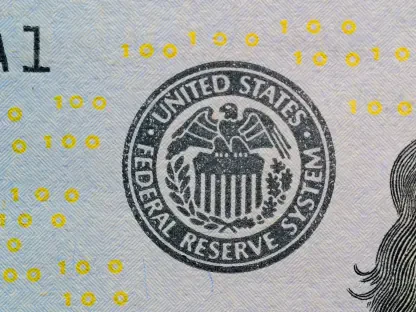The U.S. stock market is grappling with a troubling downturn that has sent major indices like the S&P 500, Dow Jones Industrial Average, and Nasdaq Composite into a steep decline, shaking investor confidence across the board. This slump is not a random occurrence but a result of significant pullbacks in high-momentum sectors such as artificial intelligence (AI) technology stocks and cryptocurrencies. Leading the charge in this downward spiral are prominent players like Nvidia, a cornerstone of the AI revolution, and Bitcoin, the flagship digital currency influencing related stocks. Their struggles are not isolated but are compounded by broader economic uncertainties, including the Federal Reserve’s wavering stance on interest rates and delayed economic data due to a government shutdown. As these forces collide, the market finds itself at a precarious juncture, with mixed signals from individual company performances adding to the complexity. This scenario raises pressing questions about overvaluation and sustainability in key sectors, setting the stage for a deeper exploration of the factors at play.
Sector-Specific Struggles
AI Technology Stocks Under Pressure
The AI sector, often hailed as the future of innovation, is currently facing a harsh reality check as stocks like Nvidia experience significant volatility, with a recent drop of 1.8% signaling growing investor unease. Despite an impressive 39% year-to-date gain and a history of remarkable growth, Nvidia’s recent performance has been marred by weeks of inconsistent trading. Market analysts have long cautioned that the rapid ascent of AI stocks might have pushed valuations to unsustainable levels. If upcoming earnings reports fail to meet lofty profit expectations, further corrections could be on the horizon. This fragility in a sector that has been a darling of Wall Street underscores a broader concern: the risk of a bubble in tech-heavy investments that have driven much of the market’s recent gains.
Adding to the sector’s woes, other AI-related companies like Super Micro Computer have seen even steeper declines, with a 6.4% drop reflecting a sharp erosion of confidence among investors. This downturn is not merely a numbers game but a reflection of deeper skepticism about whether the AI boom can deliver consistent returns in an increasingly jittery economic environment. Unlike Nvidia, which still holds a strong long-term outlook, smaller players in the space are finding it harder to weather the storm of heightened scrutiny. The disparity in performance within the sector highlights how dependent investor sentiment has become on blockbuster results, with any shortfall triggering swift and severe market reactions. As this high-growth area faces mounting pressure, the ripple effects are felt across the broader indices, amplifying the overall market decline.
Cryptocurrency Market Volatility
Bitcoin, the leading digital currency, has taken a significant hit, sliding below $92,000 after recently peaking near $125,000, a drop that has sent shockwaves through the cryptocurrency market and beyond. This sharp reversal has directly impacted related stocks such as Coinbase Global and Robinhood Markets, which saw declines of 7.1% and 5.3%, respectively. The high-momentum nature of crypto investments, often driven by speculative fervor, makes them particularly susceptible to such rapid shifts in sentiment. As skepticism grows about the sustainability of digital currencies in a volatile economic climate, the market is forced to reassess whether these assets can maintain their value over the long term. This downturn is a stark reminder of the inherent risks in a sector that thrives on hype but struggles under scrutiny.
Beyond Bitcoin’s price drop, the broader crypto ecosystem is grappling with questions of legitimacy and stability, as regulatory uncertainties and market fluctuations continue to unsettle investors. The interconnectedness of crypto stocks with the digital currency’s performance means that any dip in Bitcoin’s value can trigger a cascading effect, dragging down companies that rely on trading volumes and investor interest in cryptocurrencies. Unlike traditional assets, the crypto market lacks the historical data and established frameworks to predict recovery patterns, leaving stakeholders in a state of heightened caution. This volatility mirrors the fragility seen in other high-growth sectors, reinforcing the notion that speculative investments are often the first to falter when economic headwinds intensify, contributing significantly to the broader market’s downward trajectory.
Macroeconomic and Global Influences
Federal Reserve Policy Dilemmas
The Federal Reserve’s approach to interest rates, once seen as a potential lifeline for a slowing job market through anticipated cuts, is now mired in uncertainty, creating ripples of unease across financial markets. With inflation stubbornly hovering above the Fed’s 2% target, coupled with delays in critical economic data due to a government shutdown, some officials are advocating for a more cautious stance. The fear is twofold: lowering rates might fuel further inflation, while maintaining or raising them could stifle economic growth at a time when stability is desperately needed. This delicate balancing act has left investors on edge, as the market had previously priced in expectations of monetary easing to boost stock valuations. The upcoming release of the delayed September jobs report is anticipated to play a pivotal role in shaping both Fed decisions and overall market sentiment.
Further complicating the situation is the potential for the Fed to pause rate cuts in the near term, a move that contrasts sharply with earlier Wall Street optimism for continued support through monetary policy. Analysts suggest that a shift to reactive rate adjustments, possibly not until next year, could signal the end of an era of easy gains for stocks, as the central bank prioritizes inflation control over preemptive economic stimulus. This policy uncertainty acts as a drag on investor confidence, particularly in sectors reliant on cheap borrowing to fuel growth. The market’s reaction to such developments is likely to remain volatile, as stakeholders grapple with interpreting mixed signals from economic indicators and Fed communications. This layer of macroeconomic doubt exacerbates the challenges already faced by high-momentum sectors, deepening the market’s current struggles.
Global Economic Context
On the international stage, stock indices are displaying a patchwork of responses that add another dimension to the U.S. market’s challenges, with Tokyo’s Nikkei 225 slipping 0.1% following reports of a 1.8% annual economic contraction in Japan for the July-September quarter. This decline reflects broader concerns about global growth slowing at a time when domestic issues in the U.S. are already weighing heavily on investor sentiment. Europe, too, is seeing modest downturns in key indices, signaling that economic headwinds are not confined to one region. These international trends suggest that the struggles of U.S. markets, driven by specific sectors like AI and crypto, are unfolding within a larger context of global economic fragility, making recovery prospects more complex and uncertain.
In contrast, South Korea’s Kospi has bucked the trend with a 1.9% rise, propelled by strength in technology stocks, illustrating that not all regions are equally affected by the downturns seen elsewhere. This divergence highlights how local economic conditions and sector-specific dynamics can create varied outcomes, even as global interconnectedness ties markets together. For U.S. investors, these mixed international signals serve as a reminder that while domestic challenges like Nvidia’s volatility and Bitcoin’s slump are significant, external factors can either mitigate or magnify the impact. The broader global landscape thus remains a critical lens through which to view the current market decline, offering both cautionary tales and potential areas of resilience that could inform future investment strategies.
Final Reflections on Market Dynamics
Reflecting on the tumultuous period that unfolded, the U.S. stock market found itself ensnared by a confluence of sector-specific corrections and overarching economic uncertainties that tested the resilience of even the most robust indices. The sharp declines in AI giants like Nvidia and the cryptocurrency market, exemplified by Bitcoin’s fall, underscored a critical reevaluation of high-growth investments that had previously soared to record heights. These events, compounded by the Federal Reserve’s hesitance on rate cuts and delays in key economic data, painted a picture of a market wrestling with both internal vulnerabilities and external pressures. Looking ahead, investors would be wise to closely monitor upcoming earnings from pivotal companies and the delayed jobs report, as these could serve as bellwethers for market direction. Adjusting portfolios to balance exposure to volatile sectors while seeking value in underappreciated stocks may offer a path to navigate the ongoing turbulence. As global trends continue to influence domestic outcomes, a nuanced approach to risk management will be essential for weathering potential further declines.









